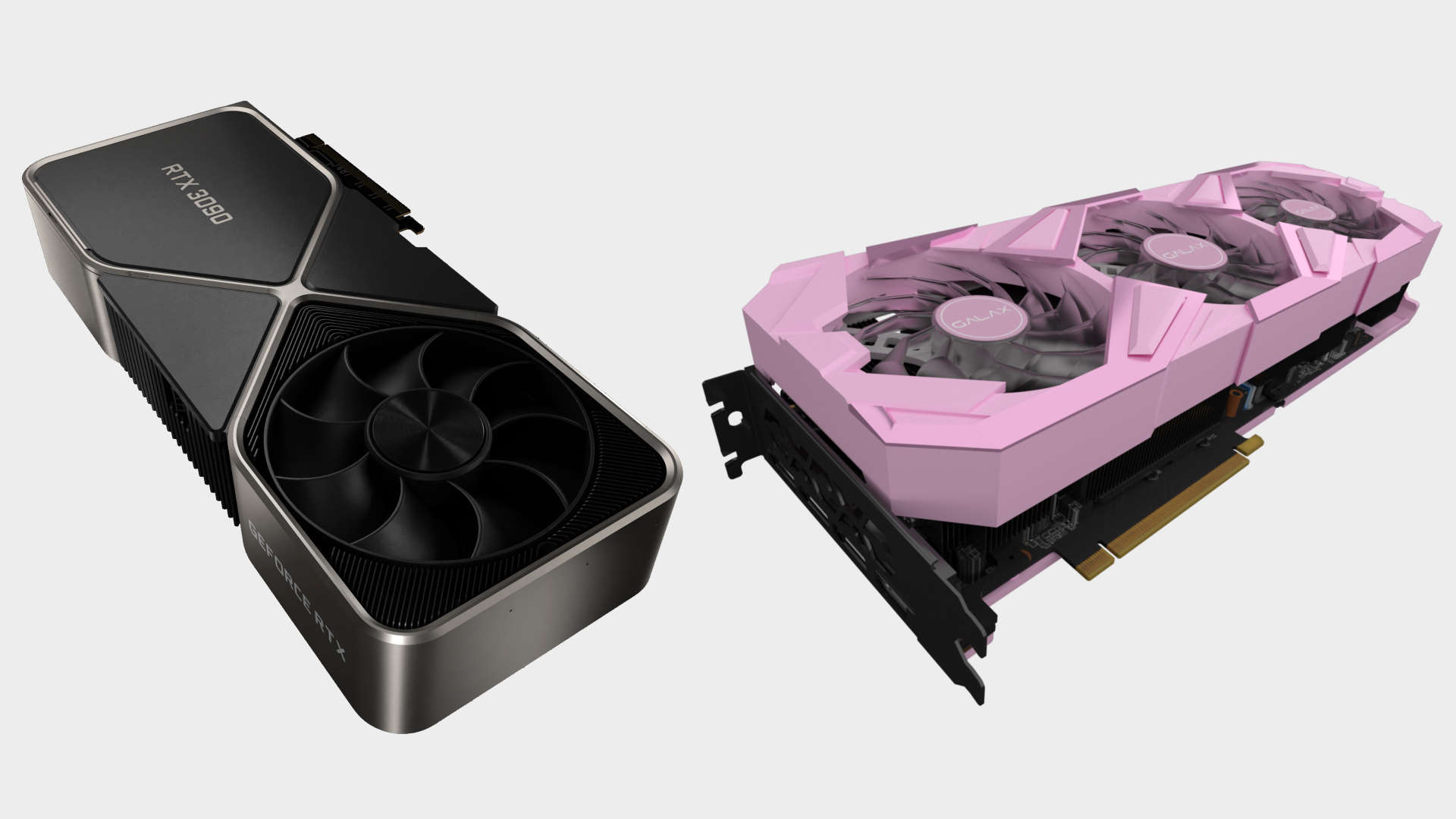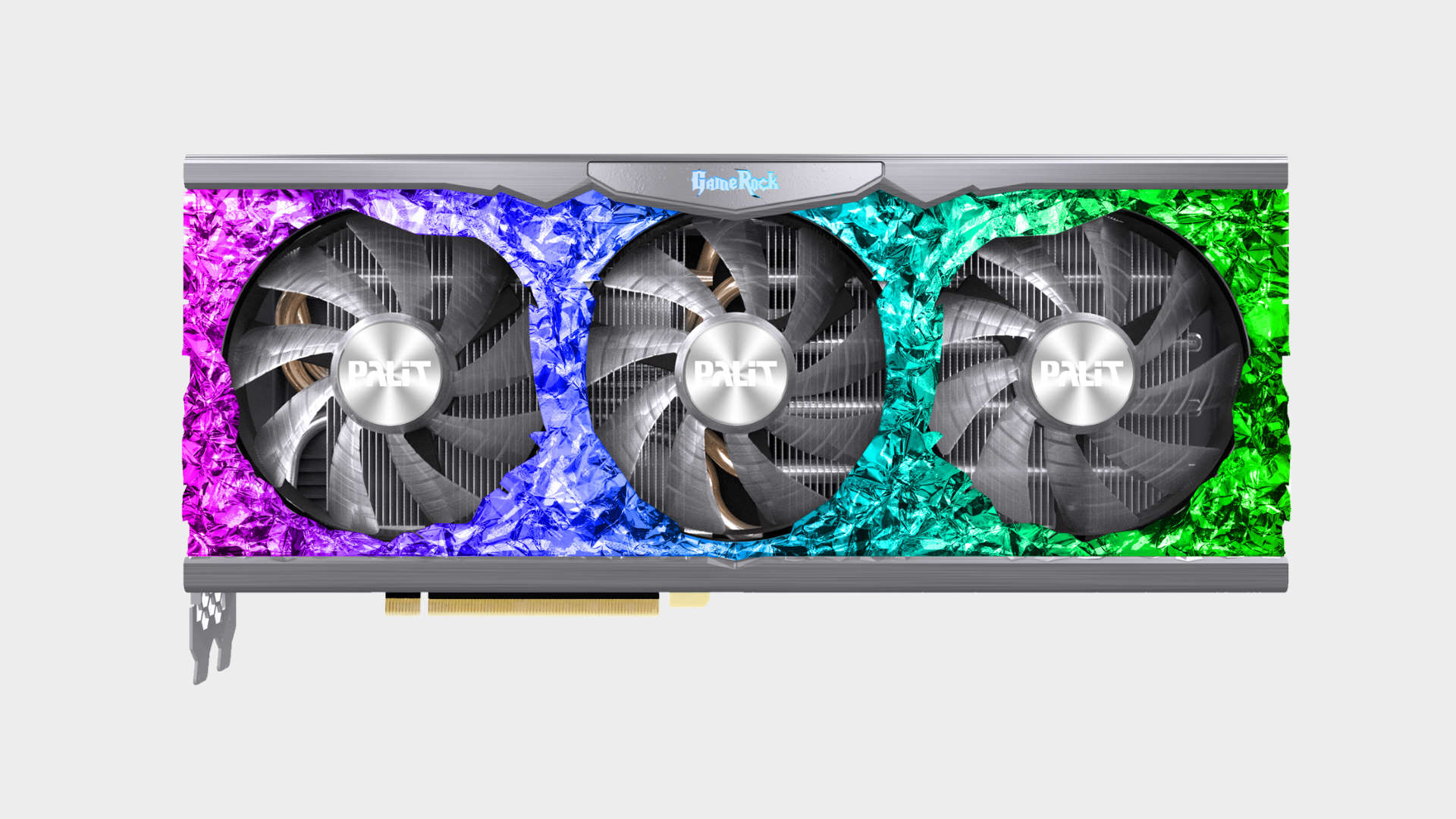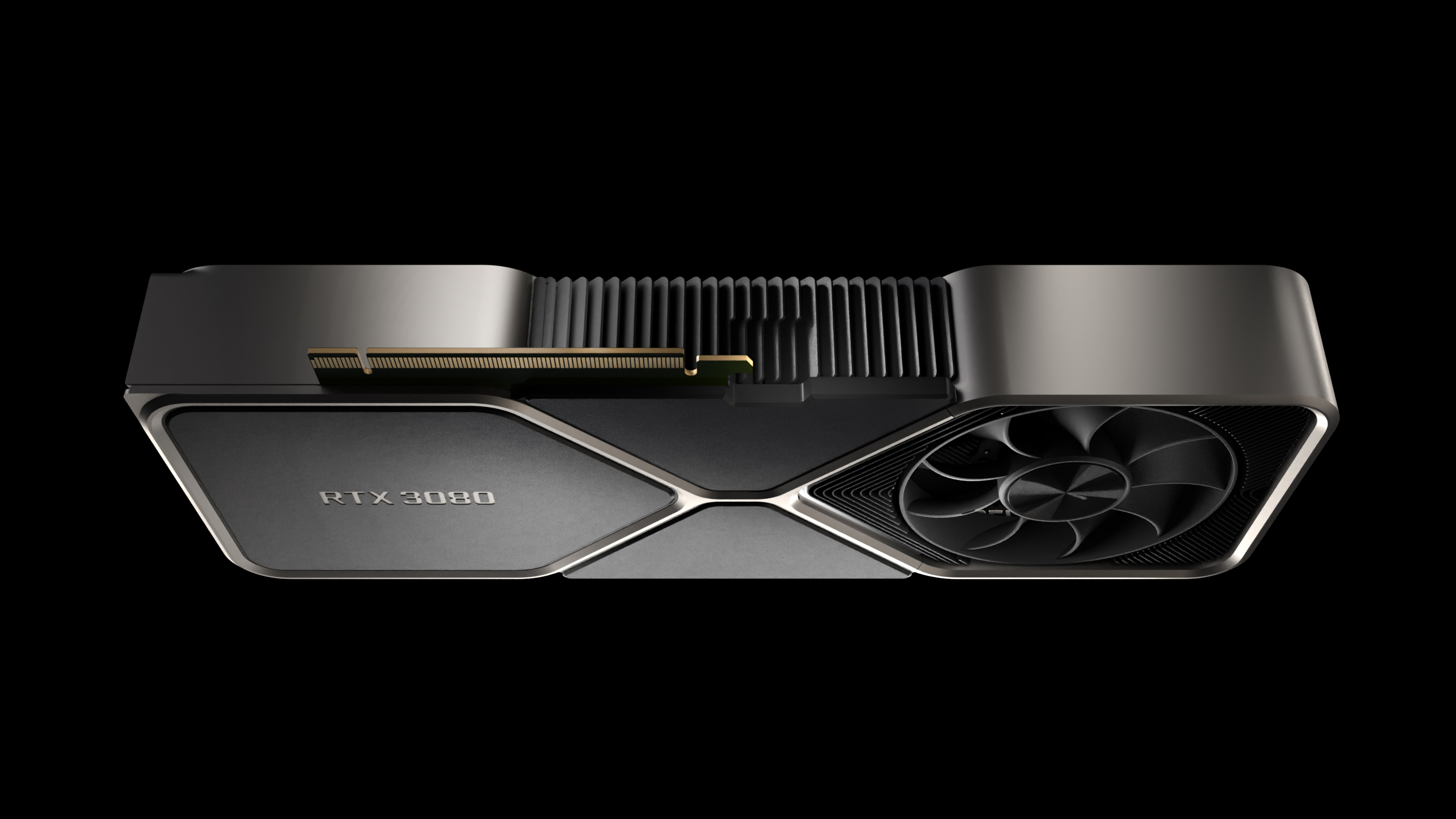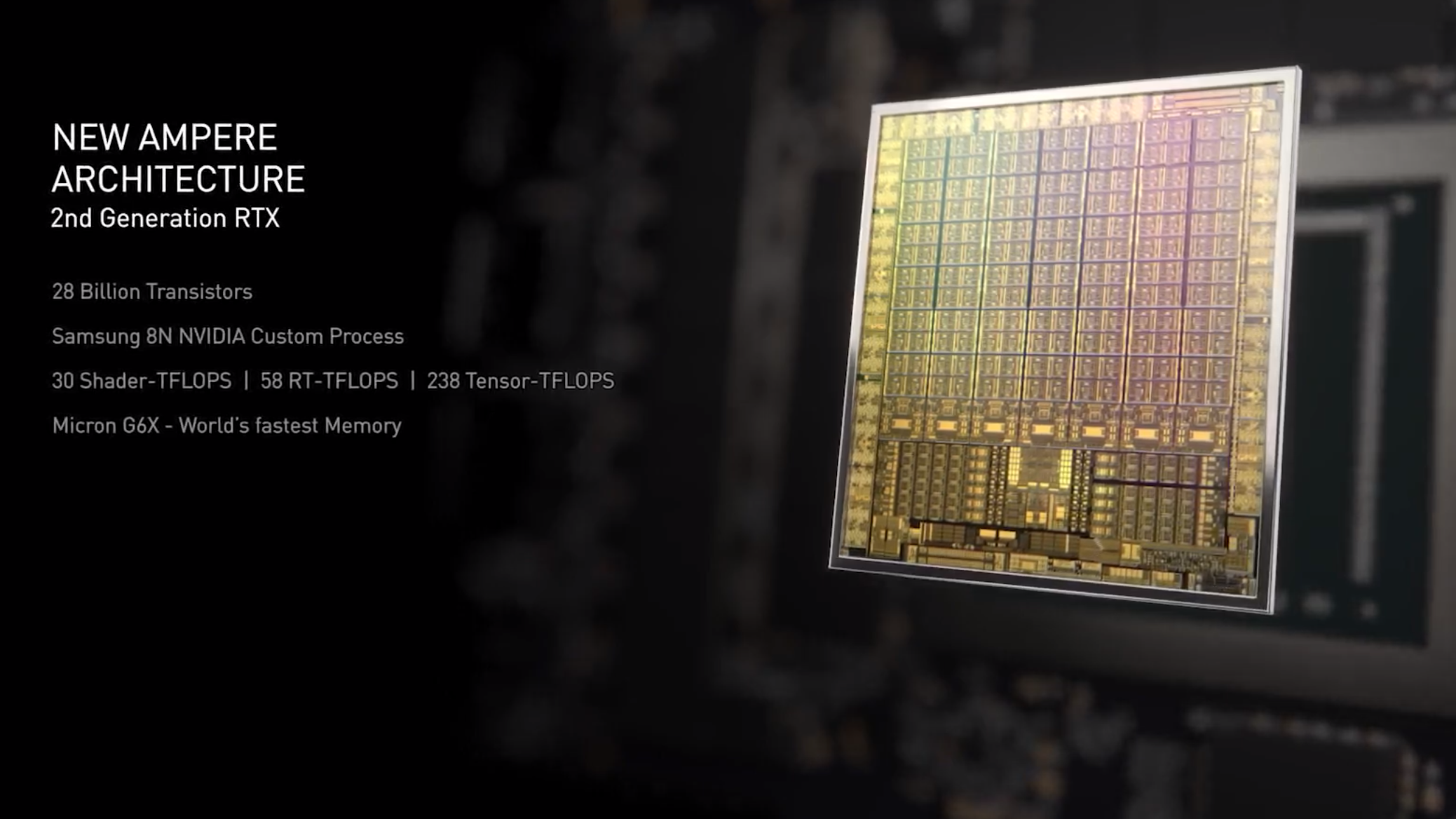Nvidia RTX 30-series: Should I buy Founders Edition or third-party?
Should you buy on pricing, specs, looks, or availability?

I don't think it's an exaggeration to say there are a whole lot of people who really desperately want to get their hands on an Nvidia Ampere GPU right now. Whether that's the sumptuous RTX 3070, the meaty RTX 3080, or the frankly ludicrous RTX 3090, half the PC Gamer team, and a load of folk at the end of my phone, want to get themselves a new 30-series GPU.
But the question I'm being asked the most is: Do I buy the Nvidia-made Founders Edition with the under-and-over fan and bow-tie shroud design, or one of the many third-party cards from Asus, MSI, Gigabyte, and others?
It's a toughie, especially with the cards still a few weeks away from launch and the add-in board (AIB) partners still not divulging the full specs of their own cards, but we're getting a pretty good idea on pricing now. And we can, at least, see what they all look like. We've even had a good look at the most 'extra' RTX 30-series cards that are going to be on offer, and they really are something.
If we're just going by looks and price, c'mon, it's obviously Palit's GameRock, a Swarovski-esque graphics card that probably won't look cheap and tacky once you stick some juice through the RGB LEDs sat behind it.
Look, if you've got yourself some of G.Skill's genuinely excellent, though unbelievably blingy, Trident Z Royal RAM in your rig then you owe it to yourself to go for the GameRock. Luckily it's available in all flavours of Nvidia Ampere RTX 30-series graphics card, so you don't have to make a difficult decision on GPU of choice.

Now we've got that out of the way, the rest of us, without a single diamond stud in our ear, can have a chat about what else we need to pay attention to.
Honestly, now that I've seen the Founders Edition outside of the dodgy leaked pictures and super-smooth renders, I've come around to its design. It's a far more grown-up look for a graphics card than you're going to see from pretty much any of the AIBs. The smooth edges, clean lines, and subdued look works for me. There are a lot of grills, but hey, if it's quiet I'm all for it.
The biggest gaming news, reviews and hardware deals
Keep up to date with the most important stories and the best deals, as picked by the PC Gamer team.
Though obviously that's a consideration. AIB cards may not look as stylish on the whole, depending on your tastes, but often they will offer superior cooling and quieter operation. There's no way, without comparative testing, to talk about that right now, however.
But on looks alone, the Founders Editions would actually be the ones I'd go for. Which means eating some humble pie for what I might have said about that shroud before.

Pricing-wise we haven't been able to find much detail about US AIBs, but Overclockers UK has listings for a huge number of 30-series cards, and that means we can make some calls about what different cards might cost given the relative Founders Edition pricing on the UK version of the GeForce store.
The short of it is that there are a large number of cards at the base MSRP of the RTX 3070 ($499), RTX 3080 ($699), and even the RTX 3090 ($1,499). Before OCUK published the expected pricing of the cards on its books we were anticipating that the monstrous RTX 3090, with its 10,496 CUDA cores, would end up hitting the £2,000 ($2,650) mark once the AIBs got their hands on it and started cranking out factory overclocked versions.
And there will be factory OC versions for sure—a bunch are already listed—though only the Palit GamingPro OC has the gaul to estimate a boost clock. It's hedging its bets rather, to be fair, as it's only some 25MHz higher than the reference boost clock of the Nvidia Founders Edition card. But then it is only £30 more expensive than the base MSRP.
| Graphics Card Name | RTX 3090 | RTX 3080 | RTX 3070 |
|---|---|---|---|
| GPU Name | Ampere GA102-300 | Ampere GA102-200 | Ampere GA104-300 |
| Process Node | Samsung 8N | Samsung 8N | Samsung 8N |
| CUDA Cores | 10,496 | 8,704 | 5,888 |
| Boost Clock | 1,700 MHz | 1,710 MHz | 1,730 MHz |
| Memory Capacity | 24 GB GDDR6X | 10 GB GDDR6X | 8 GB GDDR6 |
| Memory Bus | 384-bit | 320-bit | 256-bit |
| Bandwidth | 936 GB/s | 760 GB/s | 512 GB/s |
| Memory Speed | 19.5 Gbps | 19 Gbps | 16 Gbps |
| TDP | 350W | 320W | 220W |
| Recommended PSU | 750W | 750W | 650W |
| Price | $1,499 | $699 | $499 |
| Release date | September 24 | September 17 | October |
Even Asus' ROG Strix RTX 3090 and MSI's Gaming X Trio versions are being rather reserved in their pricing, with price tags of £1,569 and £1,499 respectively they're just £170 and £100 ($225 and $132) more than the reference cards. I guess once those liquid-cooled versions start popping up then we might well see them getting closer to £2,000.
The really big question, however, is one of availability
But it's worth saying that there are AIB cards listed on Overclockers UK that cost less than the MSRP Nvidia has put out there. We may have picked on Palit before but its RTX 3070 GamingPro is listed for £20 less than the £469 sticker price on the GeForce store. That's £449 if you can't be bothered to do the maths.
Basically, you can expect that, around launch, there will be cards with pricing that doesn't make a mockery of the initial announcement from Nvidia CEO Jen-Hsun Huang's kitchen this week. There will be higher-clocked, and therefore more expensive cards, but there might even be cheaper options too.
The really big question, when it comes to whether you go for an AIB or Founders Edition, however, is one of availability.
There has already been some rumour-mongering around the potential limited availability of Nvidia Ampere RTX 30-series cards. And, if we're honest, there is a good chance that early inventory will sell out quick. This is a hotly anticipated generation of graphics cards, and the hype is real. Even more so since the GeForce Special Event unveiling.
But it's about who will sell out fastest, and who can manufacture and restock quickest. Personally, I'm of the opinion that one of the reasons that you're going to see third-party cards launching at the same time as the Founders Editions is so that there is significant stock on release day.
I expect the Nvidia-made Founders cards will sell out on Nvidia's own store first, with retailers more likely to have GPUs available after those run dry. How quickly Nvidia will be able to restock we don't know, but I would anticipate, because of the number of different AIBs offering silicon, that retailers will be able to find cards pretty rapidly.
So long as the GPUs are there to stick under those different shrouds, anyway.

Nvidia seems to be relatively confident about the number of chips Samsung can squeeze out of its 8N fabs, and it's possible one of the reasons the green team opted for the Korean silicon giant is because semiconductor rival, and AMD partner, TSMC, has a whole lot of pressure on its 7nm production. AMD has both CPUs and GPUs in manufacture at TSMC, and Apple has a not-inconsiderable draw on its resources either.
Samsung, however, might be more able to turn around a whole lot of 8N Nvidia Ampere silicon in order to keep the virtual tills ringing at the different retailers around the globe looking for new GPUs.
In the end, there are still a lot of unanswered questions about the different RTX 30-series cards on offer. Personally, I would suggest making a beeline for the Founders Edition cards first, but those may well run dry quick, which means making your selection from the AIB offerings instead.
But that doesn't mean compromising on price, and likely not on performance either. Nvidia's Founders cards don't seem to be factory overclocked in this generation, so MSRP partner cards will perform just as well.
If you want the absolute highest performing versions of Nvidia's greatest generational graphics card leap then there will be factory overclocked cards just waiting for you to drop a healthy price premium on them.
There are no pre-orders live yet and I would say that before making any decisions, that you should keep an eye on actual independent reviews. There will, of course, be a Radeon response from AMD, and potentially very soon, so it might also be worth waiting to see what the RDNA 2, Big Navi cards might have to offer.
We'll have the RTX 3080 Founders Edition tested for launch, and a host of third party cards will be hitting our test rig in the next week or so, too.

Dave has been gaming since the days of Zaxxon and Lady Bug on the Colecovision, and code books for the Commodore Vic 20 (Death Race 2000!). He built his first gaming PC at the tender age of 16, and finally finished bug-fixing the Cyrix-based system around a year later. When he dropped it out of the window. He first started writing for Official PlayStation Magazine and Xbox World many decades ago, then moved onto PC Format full-time, then PC Gamer, TechRadar, and T3 among others. Now he's back, writing about the nightmarish graphics card market, CPUs with more cores than sense, gaming laptops hotter than the sun, and SSDs more capacious than a Cybertruck.

